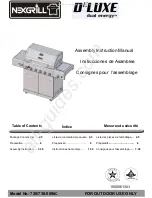
20
DO'S & DON'TS
DO..
? Have propane cylinder (LP units) filled by
authorized LP supplier.
? Record your grill model number on your
instructions and keep the instructions and parts
list in a convenient place.
? Check all gas line connections for leaks with
soapy solution prior to lighting, tighten until
bubbles disappear.
? Raise the hood before lighting the burner.
? Preheat the grill 5 minutes maximum before
cooking.
? After cooking, turn the grill off, then take a long
handled soft brass bristle brush and brush off
the cooking grills. Then turn off gas at the
Propane tank or main valve.
? Use a mitt to turn off tank valve, it can get hot.
? Cook with hood down when possible. It is
generally
faster and more efficient. Trapped
smoke adds to the flavor.
? Turn the gas off promptly should you be
unable to light the grill immediately. Wait a full
5 minutes before attempting to light grill again.
? Have proper tools, tongs, mittens and hot pads
ready prior to removing foods.
? Trim excess fats from meats to minimize flare-ups.
? Let the grill cool before removing any parts for
cleaning.
? Be careful of the control valve setting. LP gas
is hotter and the lower setting may be generally
preferred.
? Cover the barbecue when not in use.
? Use a mitt or glove when opening BBQ lid or
turning off Propane tank valve after use.
DON'T..
? Install grill closer than 14" on the sides or 16"
on the back to any combustible construction.
? Attempt any adjustment of the regulator, it has
been preset and tested.
? Allow the LP tank to lie on its side. Keep in an
upright position.
? Use plastics or untempered glass utensils on
the grill.
? Attempt to move an aluminum foil pan while it
is hot. Let it cool first before moving it.
? Cover or block any air openings in the bottom
of the grill with foil.
? Wear long, loose flowing clothing around the
grill. Long flowing hair is also easily ignited
especially by unexpected flare-ups. Tie hair
back or wear a hat or a scarf.
? Put food on the grill and leave it unattended or
unwatched for long periods. Most fats can
catch fire even on the lower setting.
? Clean Flame Tamers in any solution other than
a boiling detergent water. Then rinse well, dry
and reuse.
? Use caustic materials, i.e., lye , to clean grill
parts.
? Store any additional Propane gas tanks under
barbecue. When cooking with hood closed NEVER
exceed temperatures of 480°F (250°C).
Summary of Contents for SO26BQRTR
Page 18: ...18 Parts Exploded View ...

































